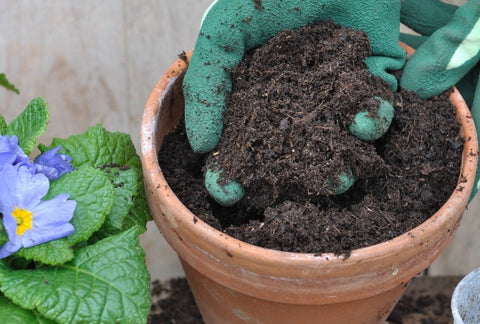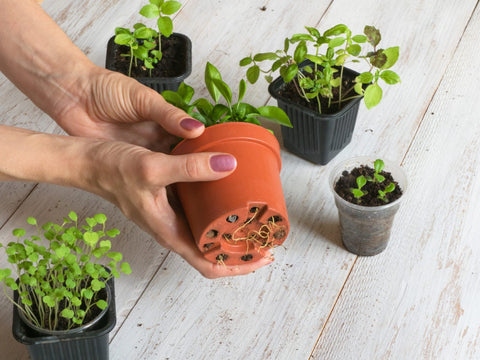When finding the perfect forever home for your plants, two key elements should be top of mind before you start repotting: pots and potting mix. Typically, you’ll want to size up your pot and add fresh potting mix so your plants receive the nutrients they need to thrive in their new space. With countless options available, we’re here to help you make the right choice. Let’s dive in!
How to Select the Right Pot

Choosing a pot is straightforward when you know what features to look for:
- Ensure the pot has adequate drainage.
- Match the pot size to the plant size.
- Understand the pros and cons of different pot materials, summarized below.
Drainage
Make sure your pot has a drainage hole at the bottom to prevent overwatering and root rot, which can attract fungus gnats and mold.
Size
The pot size dictates how many and what type of plants can grow happily. If planting multiple plants in one pot, it’s okay if the pot is slightly larger than the guidelines suggest.
Pots for Different Plant Types
Herbs
Most herbs are content in smaller pots. For indoor growing on a windowsill, opt for pots no smaller than 4 inches. Outdoors, use 6-inch pots or larger. The table below provides the minimum pot size for various herbs, but larger pots yield bigger harvests.

Vegetables
Vegetables require more space but can thrive in containers. For our container-friendly veggie seed pack, use larger containers to allow for companion planting, such as tomatoes and basil.

Materials for Pots
Each material has its pros and cons:
Plastic
Pro: Inexpensive, lightweight, and often come with more drainage holes. Safer around children.
Con: Ecological concerns with single-use plastics, and they typically last only a few seasons.
Wood
Pro: Biodegradable, eco-friendly, and aesthetically pleasing.
Con: Can rot over time if not maintained and may not be sustainably sourced.
Terracotta
Pro: Aesthetically pleasing, regulates temperature, and is porous.
Con: Heavy, requires frequent watering, and can break easily.
Fabric
Pro: Inexpensive, good aeration, and biodegradable.
Con: Requires a lot of water and typically lasts only 2-3 seasons.
How to Select the Right Potting Mix

Now that you have your pot, it’s time to choose the right potting mix. The type of plant will dictate the best potting mix, but overall, it needs to allow adequate drainage. While ready-made potting mixes are available, understanding their components helps you provide the best care for your plants. Here are common ingredients found in potting mixes:
Organic Plant or Animal-based Components
Includes peat moss, rice hulls, aged bark, manure, compost, and coconut coir. These materials help retain water and release nutrients essential for plant growth.
Inorganic Natural Components
These include perlite, vermiculite, pumice, sand, and cinders, which aid in aeration and drainage.
Fertilizers
Essential for providing nutrients. Choose organic materials such as alfalfa, bone, and kelp meals for edible plants.
Other Additives
May include lime to balance pH levels, beneficial microbes, and wetting agents to retain moisture.
Potting Mix for Different Plant Types
While you can purchase ready-made potting mix, we suggest trying our DIY potting mix recipe. Use the provided ratios to create your mix, and combine thoroughly with water to bind the elements.
Herbs

Vegetables

Now that you know how to select the right pot and potting mix for your plants, you’re ready to expand your indoor garden! Sign up for more tips on getting the most out of your urban garden.






